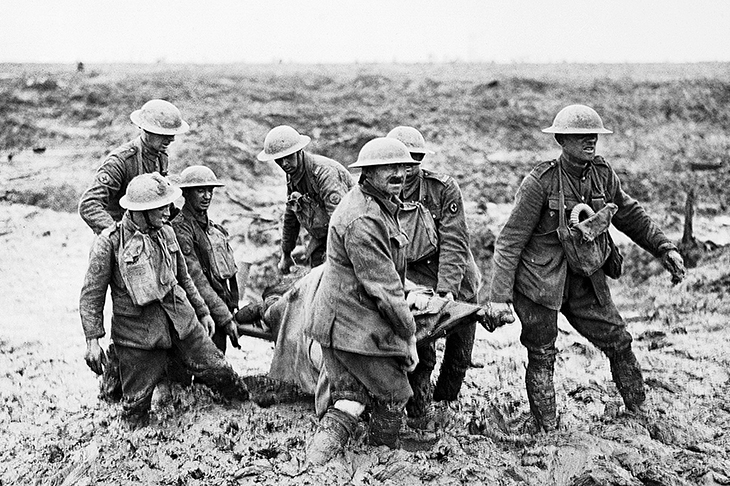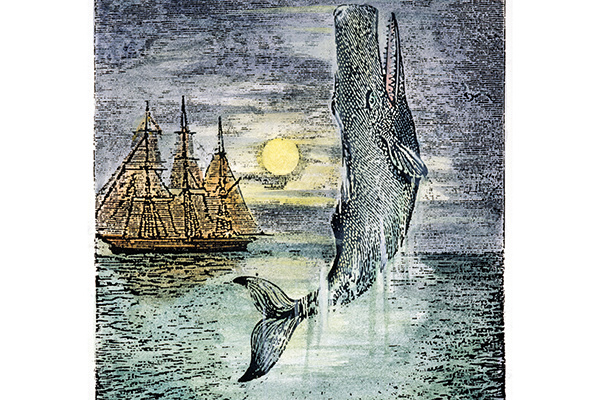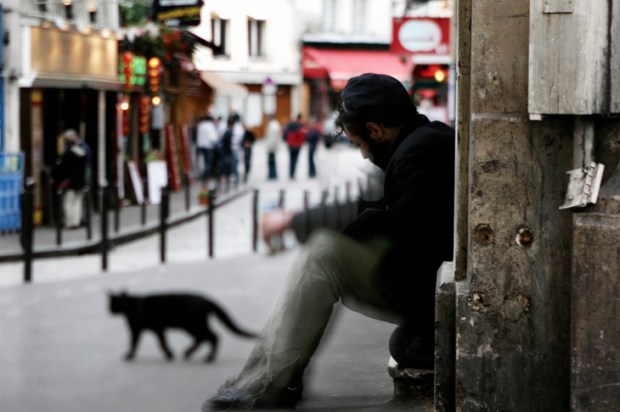George Orwell’s suggestion that the British remember only the military disasters of the first world war is certainly being borne out by the centenary commemorations. The focus of each year so far has been Gallipoli, the Somme and now the Third Battle of Ypres, popularly known as Passchendaele. The basic story is familiar. On 31 July 1917, in torrential rain, General Haig launched an attack against German positions in the Ypres Salient. The troops had to advance over ground that rapidly turned into a quagmire, shells having already destroyed the area’s network of drainage ditches.
The attacks would continue sporadically, against the advice of those on the ground and often in atrocious weather, until November. Men were repeatedly ordered towards impossible objectives against overwhelming odds, with the result that little was gained at a huge cost. ‘It’s just not conceivable how human beings can exist in such a swamp, let alone fight in it,’ a pilot flying over the battlefield commented.
Early historians agreed. ‘So fruitless in its results, so depressing in its direction was this 1917 offensive,’ wrote Basil Liddell Hart in 1934, ‘that “Passchendaele” has come to be a synonym for military failure, a name black-bordered in the records of the British Army.’ The Allies eventually captured Passchendaele Ridge, but four months later, during the German Spring Offensive, they were forced to abandon this shockingly hard-won ground. Quite as much as the Somme, Passchendaele has become a locus for the enduring ‘mud, blood and futility’ view of the first world war.
This view is now routinely challenged by ‘revisionist’ historians, who assert that even the most catastrophic battles were not entirely futile because military lessons were learned from them. Not, it would seem, by General Haig, who appears to have adopted more or less the same tactics at Passchendaele as he did at the Somme — with better artillery but in much worse weather. Haig also appeared to overlook, or disregard, one of the basic rules of warfare: that defending forces almost always have the advantage over attacking ones, something that was particularly true at Passchendaele, where the Germans occupied higher ground.
In two excellent histories of the battle, Paul Ham and Nick Lloyd are at pains not to present Haig as the callous incompetent of legend; but their accounts of his character and conduct are pretty damning. Haig’s original objective was to push the Germans back across Flanders and destroy the German submarine bases on the Belgian coast. This put him at odds with the Prime Minister, Lloyd George, who feared that a continuing campaign on the Western Front would result in an unacceptable number of casualties, for which he would be blamed. He did all that he could to frustrate Haig’s plans without ever actually stepping in to stop the battle, as he had said he would if it became clear that the human cost was growing too great.
Paul Ham concludes that the tragedy of Passchendaele was largely the result of a highly personal clash between these two very powerful personalities, and that Haig more or less abandoned his original plan in order to pursue a war of attrition. He is particularly critical of Lloyd George, whom he characterises as scheming, untruthful and self-serving.
Nick Lloyd takes a more lenient view of the PM and suggests that
Haig’s popular reputation as a stolid commander, unimaginatively following a stale doctrine of attrition, masks the truth that he was a compulsive gambler, with the compulsive gambler’s habit of throwing good money after bad.
Haig’s principal flaw was indeed his unquenchable optimism, partly derived from his belief that he was being divinely guided to victory and partly from his routine dismissal of intelligence suggesting the German army was less near collapse than he liked to believe. Haig also favoured the wrong commanders, preferring the intemperate General Gough to the methodical General Plumer. It was Plumer who had planned the spectacularly successful attack on Messines Ridge before the main battle was launched. After months of laborious tunnelling by specialist teams (particularly well described by Ham), 19 huge mines laid beneath the commanding ridge were detonated in the early hours of 7 June, and what little was left of the German positions was overrun.
The advantage gained was subsequently squandered because Haig insisted on using Gough’s Fifth Army for the next stage of the battle and acceded to the general’s request for more time. This ‘fatal delay’, as both Ham and Lloyd call it, allowed the Germans to prepare for the coming onslaught. Haig’s perpetual dream was of decisively breaking through the German line, but Plumer’s more modest ‘bite-and-hold’ strategy, consolidating an advance before attempting another one, was far more effective than Gough’s all-out assaults, which often ended up achieving almost nothing but appalling casualties.
Both Lloyd and Ham make very good use of archives to present unpublished personal accounts of the battle from all the combatants involved, Allied and German. Ham takes time out from his unrolling narrative of the battle for compelling chapters on the dead and the wounded: many soldiers drowned horribly in shell-holes filled with liquid mud, and stretcher-parties wading through the morass sometimes took six hours to bring in casualties. Lloyd’s narrative is rather more austere, but the author has a good eye for the telling quote or detail, and his summing up is lucid, persuasive and humane.
Among the welter of other books commemorating the battle, Richard van Emden’s The Road to Passchendaele is told almost entirely in ‘soldiers’ own words and photographs’. Soldiers were not permitted to carry cameras with them, but many of them did, and the resulting photographs have an immediacy that is matched by the text, taken from letters, diaries, memoirs and reminiscences. One gets less sense here of the overall shape and conduct of the campaign than in Ham and Lloyd’s accounts; but as the longest-surviving veteran of Passchendaele, Harry Patch, said in the autobiography that van Emden helped him write:
I’ve been shown pages of the [official] War Diary, but for the most part it’s hard to relate to the record. You only knew what was right next to you, and even this was obscured by smoke or fire. Strategy you left to those higher up.
The only mention of Haig is telling: a soldier writes home after Messines: ‘The papers say Haig has pushed; they ought to say Plumer, it was entirely his affair.’
Chris McNabb’s Passchendaele 1917 is a history of the battle ‘in photographs’, most of them taken by official photographers and therefore more familiar than van Emden’s. That said, there are some extraordinarily eloquent images here: the ghastly tangle of bodies and revetments in a German trench destroyed by one of the Messines mines; the featureless, waterlogged landscape and tangled wire through which advancing Canadian troops had to find their way in November 1917; Tyne Cot Cemetery, with its original rows of wooden crosses rather than the familiar headstones of today.
Sarah Wearne’s touching and beautifully designed little book of epitaphs reproduces some of the words on those headstones, not only from Tyne Cot but other cemeteries, along with accounts of the men buried beneath them. Relatives were allowed to add inscriptions of up to 66 characters, and these ranged from proud parental laments to quotations from a wide variety of sources, all identified here: the Bible and Omar Khayyam; hymns and popular songs; Swinburne, Henley, Masefield and a host of now forgotten poets. ‘All that he has left/ Is bruised/ And irremediably bereft’ reads one, adapting Maurice Baring; ‘I’m all right Mother/ Cheerio’ reads another, quoting a letter home. Even protest was occasionally permitted: ‘Sacrificed to the fallacy that war can end war.’
Alexandra Churchill’s Passchendaele: 103 Days of Hell takes the individual stories of 103 men and women who participated in the battle, starting with one of the Messines tunnellers and ending with a ranker who had given his civilian occupation as ‘household scavenger’ and was killed on 2 December 1917, several weeks after the battle was supposedly concluded. Nurses, chaplains and stretcher-bearers are included alongside airmen and combatants from all the countries involved.
Among those commemorated are three Australian brothers all killed in the same action; the Canadian Cree Olympic athlete Alex Decoteau; and Harold Mann, a 19-year-old English private whose chin and lower jaw were more or less shot away. Mann became one of the first patients of Harold Gillies, the New Zealand father of plastic surgery, who would reconstruct some 5,000 faces of those injured in the war, and ‘before’ and ‘after’ photos of this young patient are included. Churchill’s biographies are occasionally rather too formulaic in their structure, but, like Wearne’s epitaphs, these stories remind us of something the High Command frequently forgot or chose to ignore: that all those who fought in this most terrible of battles were
sentient individuals rather than mere units of manpower.
Got something to add? Join the discussion and comment below.
Get 10 issues for just $10
Subscribe to The Spectator Australia today for the next 10 magazine issues, plus full online access, for just $10.
You might disagree with half of it, but you’ll enjoy reading all of it. Try your first month for free, then just $2 a week for the remainder of your first year.














Comments
Don't miss out
Join the conversation with other Spectator Australia readers. Subscribe to leave a comment.
SUBSCRIBEAlready a subscriber? Log in